Female Leaders Interact with SDSU Students, Faculty and Staff to Share Their Empowering Words and Inspirational Experiences
The Fowler College of Business at San Diego State University held its 6th Annual Women in Leadership Conference on March 10, 2022. Held both online and in-person this year, the audience of students, faculty, staff, alumni and community members listened and interacted with this year’s keynote speakers, panelists and workshop leader for advice, feedback and inspiration.
World-class swimmer and seven-time Olympic medalist, Amanda Beard, served as the event’s keynote speaker for the morning session, while former runway model and social activist, Halima Aden, was the keynote speaker for the afternoon session.
The program, developed by SDSU marketing lecturer, Steven Osinski, is “designed to focus on the specific issues females face in the workplace while equipping students with the skills and confidence they’ll need to thrive both as professionals and individuals.” The Osinski family has created a $500,000 endowment to continue to fund and expand the event into the near future.
Amanda Beard
During the morning keynote session, best-selling author, seven-time Olympic medalist, entrepreneur and mother of two, Amanda Beard, took the stage to discuss the challenges and triumphs she’s faced both during and after her career as a world-record-holding swimmer for Team USA.
Life as a Young Celebrity
Beard was a 12-year-old when she began swimming competitively and she was just 14
years old when she first competed at the Summer Olympics in Atlanta in 1996. She won
two individual silver medals in the breaststroke events and a gold medal in the women’s
4x100 medley relay. She gained international fame overnight as she clutched her teddy
bear on the medal stand.

Beard enjoys a light moment during the discussion.
However, her teddy bear offered her little comfort in the new glare of the public spotlight, particularly during press interviews. “When you’re 14 and getting those questions thrown your way, it can be very challenging on how to answer them,” said Beard. “After winning one of my silver medals, I went into the media room to talk about it and I was so excited. One person there asked me how it felt to lose. It was at that moment that I got the wind knocked out of my sails and it never dawned on me before that winning a silver medal was losing.”
This question had a long-lasting impact on Beard. “I believed that I let down my country, my coaches, my family and friends and it took me a really long time to recover from that one question,” she said. But there was more than just that one tough question gnawing at her cheerful public persona. “While I was in front of the cameras, I’d be like ‘I’m blessed and everything’s wonderful,’ but at home, I was struggling with injuries and body image issues,” said Beard. “My parents went through a big divorce and there were day-to-day things with relationships and breaking up with boyfriends and stuff like that. I kept going into a darker and more introverted world where I wanted to pull away from people more and more.”
Sharing Her Story with the World
The turning point for Beard came when a friend who wrote for the New York Times visited
her for an interview. “We just started talking and I just started spilling all this
stuff to her while she’s taking notes,” said Beard, who, at the time, was in her mid-20s.
“We spent five or six hours talking and she said, ‘this is a book,’ but I was like,
‘no way!”. Since these were my deepest, darkest secrets and I was still competing,
I didn’t want my competitors to hear that kind of stuff about me.”
The reporter/friend was very persuasive and eventually, Beard changed her mind. “She said, ‘trust me, there’s a huge amount of people who you can touch and change their lives’,” said Beard. “I told her, ‘Well, if we’re going to do this, I’m going to go full steam ahead with no topics off limits.”
With the idea of sharing her story so that young athletes could see they were “not alone in their journey and that it was totally normal” for them to be emotional during the process, Beard moved forward with the publication of her book. Three years after the initial interview, her story, “In the Water They Can’t See You Cry: A Memoir” was published in 2012. The book was ultimately successful and landed on the New York Times’ list of best-selling non-fiction publications.
The book addressed issues of mental health and Beard’s experiences as a top athlete and celebrity and Beard garnered praise from many who had undergone the same experiences and saw themselves in her memoir.
However, there was a dark side to opening up to the public. “I had death threats being sent to me and people showing up at book signings saying some disgusting things,” she said. “I didn’t quite understand it because I thought ‘This has nothing to do with you! This is my life and I don’t know why you care so much about my journey.’ I think it’s possible these people must be struggling as well.” But she said it was the overwhelming amount of positivity from those readers who were touched by the book’s message that allowed her to re-focus her energy in a more optimistic direction.
Author, Model, Mother Entrepreneur
Since the book’s release 10 years ago, Beard has continued to stay active as a model,
brand representative and media correspondent. She is currently concentrating on her
new business venture, Beard Swim Co. which is based in Washington state. While the mission of the company is not to turn
out Olympic swimmers, Beard emphasized that the company is focused on teaching children
to swim and to “have a healthy relationship with the water.”

Keynote speaker, Amanda Beard, with Women in Leadership founder and sponsor, Steven Osinski.
Beard is also focused on her family, including her two children. Having lived through the insecurities of her celebrity teen years, she’s intent on guiding her children away from potential emotional pitfalls. She pointed out that her son (age 12) isn’t phased by his surroundings and is “better at letting things bounce off of him.” However, her daughter (age 8) is more heavily influenced by things going on around her and needs more guidance and support “to make sure she stays on the right path.”
Both of Beard’s children participate in sports and when she was questioned about the evolution of mental health in athletics, she said that support for mental health matters in the sports industry has evolved significantly. “You’re hearing more people talk about it and make a stand for it,” said Beard. “There’s less people just pushing through it and there’s more people willing to take a little time out to reflect and get into the right state of mind.”
What is next for Amanda Beard? Beard pointed out she’s still very involved with swimming and is in the process of expanding Beard Swim Co. in order to accommodate more student swimmers. Along that same line, she’s also involved in working with getting scholarships for children to provide them with paid swimming lessons.
Now at age 40, Beard has overcome some significant emotional challenges, and even more amazing triumphs. She says that life continues to be a “healing process” for her and she says she is grateful she has a support system of friends and family to turn to when needed. Having a support team is her strongest words of advice to her SDSU audience: “Find those people that can be a support system around you. Also, find your voice and be okay with sharing it. If you don’t have that core, it’s going to be a difficult road to navigate.”
Halima Aden
Somali activist and former model, Halima Aden, closed the Women in Leadership event for 2022 with her afternoon keynote session moderated by SDSU marketing professor, Nita Umashankar. Aden was the first model to wear a hajib on the runway as well as in the Miss Minnesota USA pageant where she was a semi-finalist.
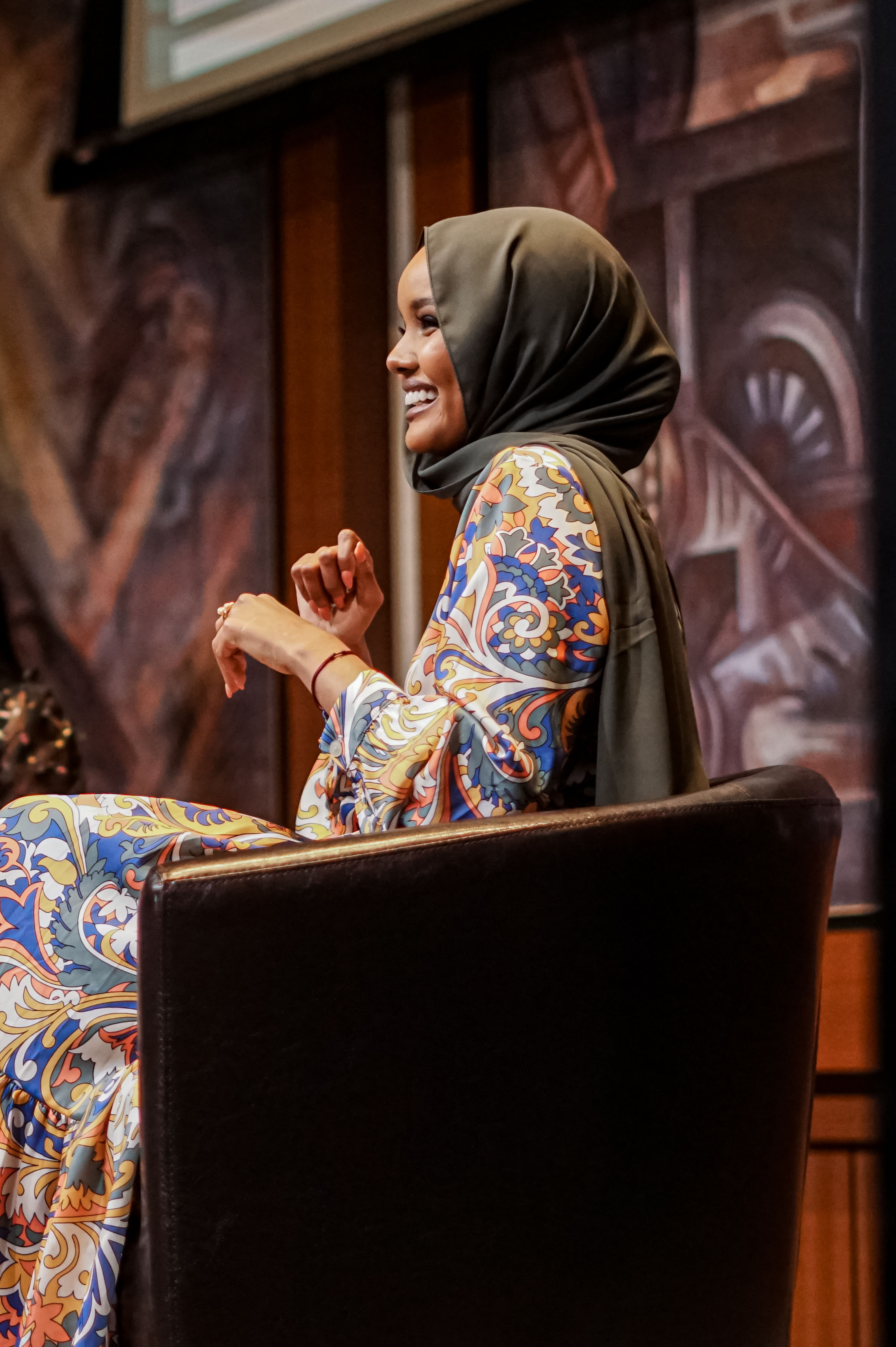
Halima Aden is a former model and activist.
The Refugee Camp Had Scars and Smiles
The session began with Aden discussing her childhood starting with her birth to Somali
parents in a Kenyan refugee camp after her mother fled their country’s civil war.
“I spent the first seven years of my life there and it had both scars and smiles,”
said Aden. “I remember the nights where we had malaria, didn’t have food on the table
— heck, we didn’t even have a table to begin with! But I also remember the joy, the
singing, the dancing, the liveliness. What people don’t have in material things, they
make up for in love and community.”
Aden and her mother left the camp when they were told that they had the opportunity to immigrate to the U.S. “I think the stereotype for refugees is that you get to migrate to a beautiful country and get to decide your fate, but in reality, it’s like winning the billion-dollar lottery,” she said. “Only about 1% actually get to come to a developed country like America. The rest either go back to their native countries or they are resettled in neighboring countries.”
Lucky
While the other refugees considered her family to be lucky and Aden’s mother was happy
to be leaving the camp, Aden said she was inconsolable because she would be leaving
her friends behind. Things didn’t improve after then-7-year-old Aden and her mother
were resettled in St. Louis. “In the camp, I had a lot of confidence, but I felt dumb
in St. Louis because the school I attended didn’t have an English as a Second Language
program and I couldn’t communicate with the staff,” she said. “Living in St. Louis
was also the first time in my life that I’d heard gunshots.”
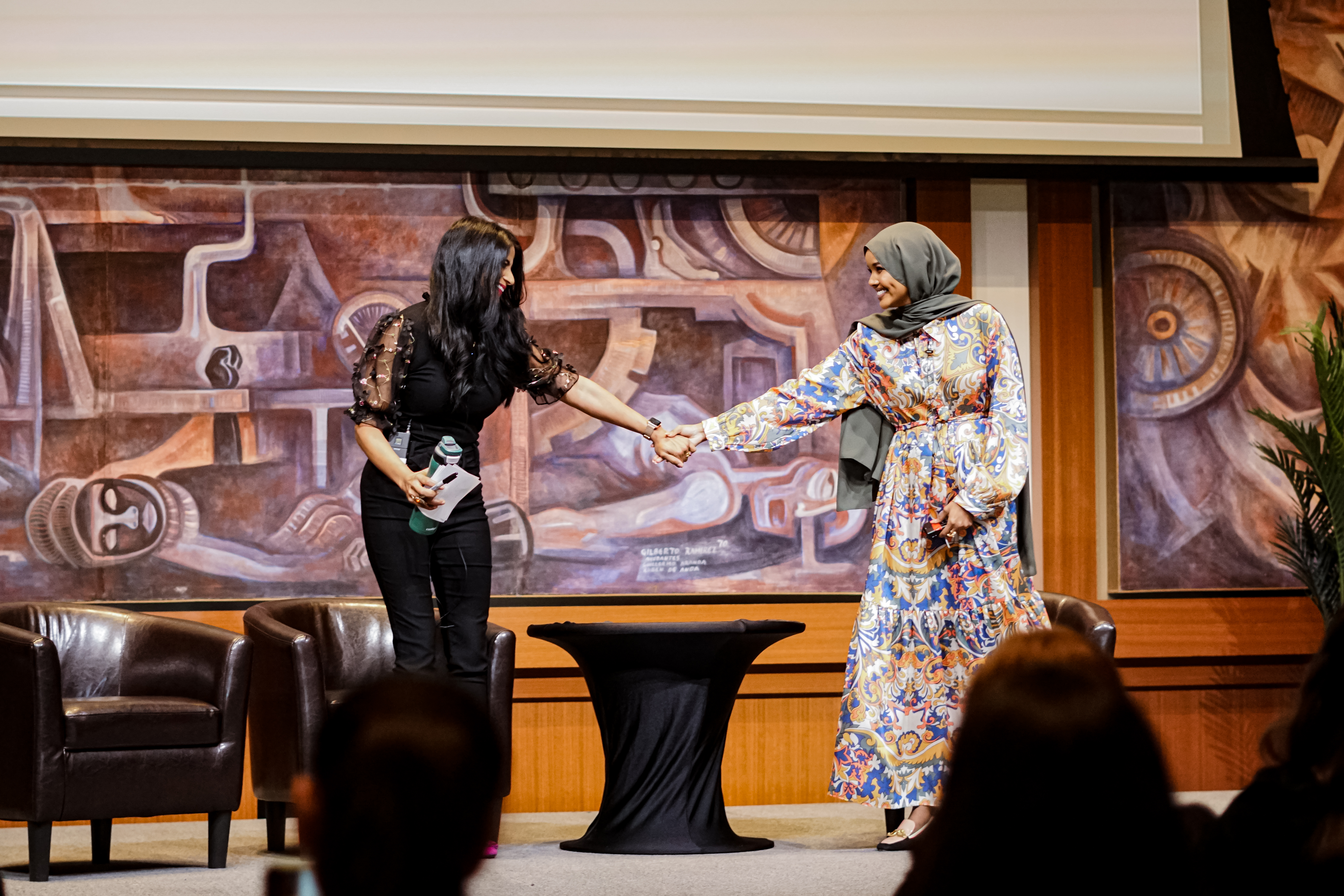
Moderator Nita Umashankar (left) greets keynote speaker, Halima Aden prior to their discussion.
But their time in St. Louis didn’t last long. Eight months after they were resettled, the family packed up and took a Greyhound bus when they moved to St. Cloud, Minnesota in 2005. While the region has a very large Somali population today, that was not the case when Aden’s family settled there. “We stuck out like a sore thumb,” she said. “We had settled into a community with its own customs and not a lot of change, and we were part of a community that brought a lot of change, so I can understand how it was hard and uncomfortable sometimes.”
In spite of those rough moments, Aden said it was her teachers that believed in her, gave her confidence and helped her with her schoolwork in those early years. One teacher told her to always “speak up — even if you have an accent, speak up.” It was advice that would serve her well later in life.
Breaking New Ground
Aden’s new-found confidence allowed her to compete in the Miss Minnesota USA pageant
in 2016. At the time, she was a freshman at St. Cloud State University, and while
she was competing in the pageant for the scholarship money, she inadvertently broke
new ground as the first contestant to compete in a hijab and a burkini. Her finish
as one of the top 15 finalists made national news, and within a week of the competition,
she received a call from singer/actor/cultural icon Rihanna’s management team asking if she would be interested in doing runway modeling.
In a matter of days, she took the second flight of her life (her first was to come to the U.S. years earlier) to New York City. Within a week, she had her first photo shoot for a magazine cover and her first runway show.
But before she signed her modeling contract, Aden wanted to stay true to herself. She made sure that a two-paragraph “hijab clause” was written into her contract to ensure that she would not be put into a situation where she would be forced to compromise her identity and values. “I didn’t know anything about contracts or legal lingo, but I did know ‘you need me more than I need you’,” she said. “So I walked into that agency with the two paragraphs I typed up with my mother that stated that I only travel with women and other things to protect myself.”
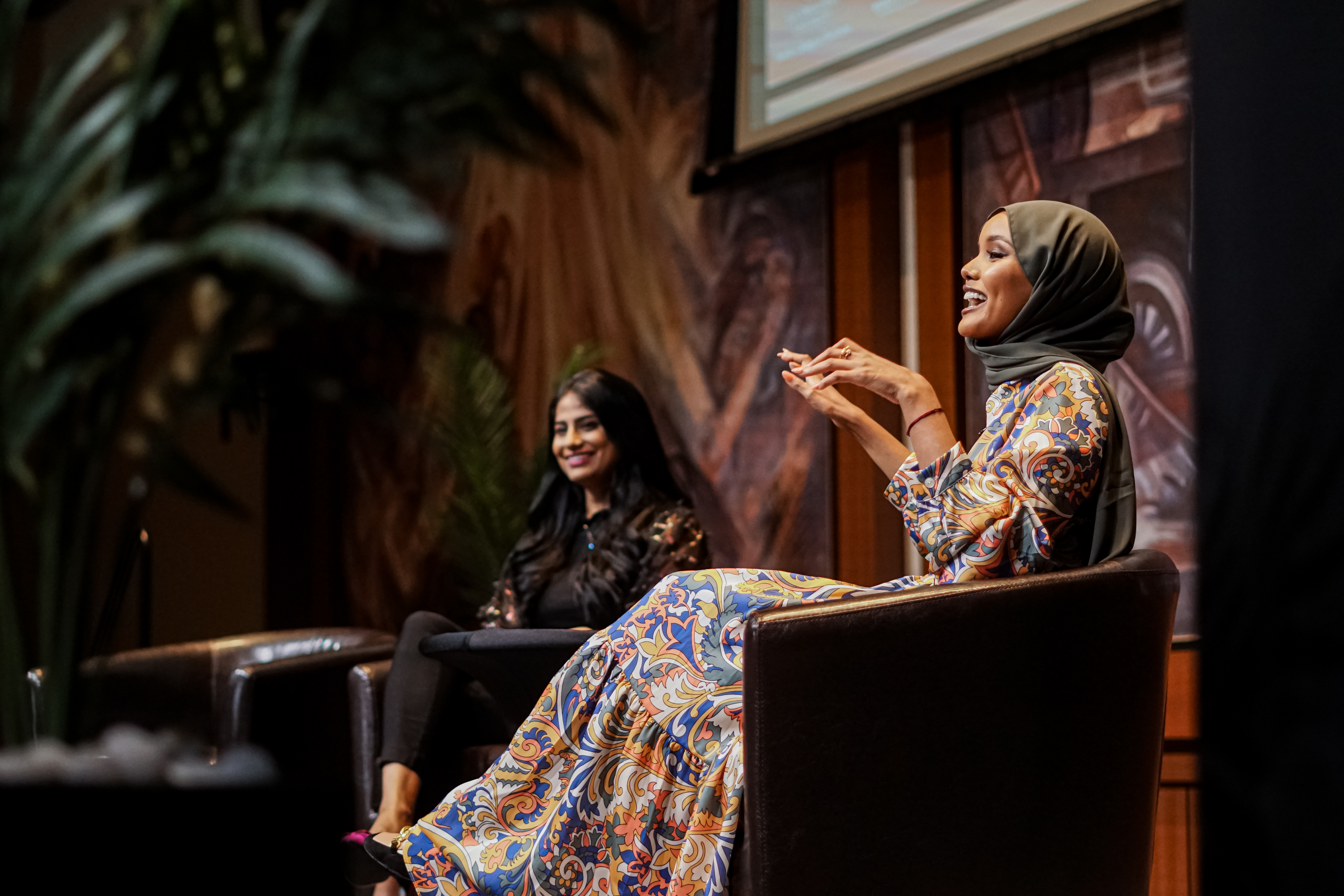
Aden answers a question from the audience during her keynote presentation.
One of the items Aden’s two paragraph clause mandated was a private dressing space during runway events. “People outside the industry don’t realize that a private dressing space was unheard of,” she said. “When it’s a busy show, the models have to go backstage and get in and out of the clothes quickly, and there’s very little separating them from the public, the photographers and even the food professionals. So from the beginning to the end of my career, there would always be a black box with curtains separating my dressing space.” Other models started following her lead and she noticed more “black boxes” the following season.
While Aden feels that the fashion industry has evolved and embraced women of color, she believes that the industry still has further to go in terms of inclusivity. “It’s actually not the 16-to-23-year-old models that are consumers of high fashion, but it’s really a group of women in their 30s and 40s. But where are the middle-aged women on the runways?’ she asked. “We now have plus-sized models, but where are women with disabilities, for example? This is also true of people that work behind the scenes in the industry and various boards of directors as well.”
What’s Next?
As she concluded her discussion, she was asked about her next project. Her answer?
“I’m writing a children’s book!”
“I want to write a book that humanizes refugee children and allows parents to have open conversations about pressing global issues,” said Aden. “I want to have a child feel like they could grow up to make changes in the world after they talk to their parents about the refugee crisis.”
SDSU Women in Athletics Panel Discuss Opportunities/Challenges for Women in the Sports Industry
This year’s first panel session brought together four women — all with ties to SDSU — who work in the field of athletics or sports business. Cathy Cooper (’21, psychology) of Girls Inc., Audra Dent (’07, public administration) the head beach volleyball coach at San Diego City College, Angela LaChica (’03, public administration) founder of LaChica Sports & Entertainment Group, and Kathy Van Wyk, the winningest softball coach in SDSU’s history joined Jenna Meyer, SDSU senior and president of the SDSU Women in Sports organization to discuss their work in the sports industry.
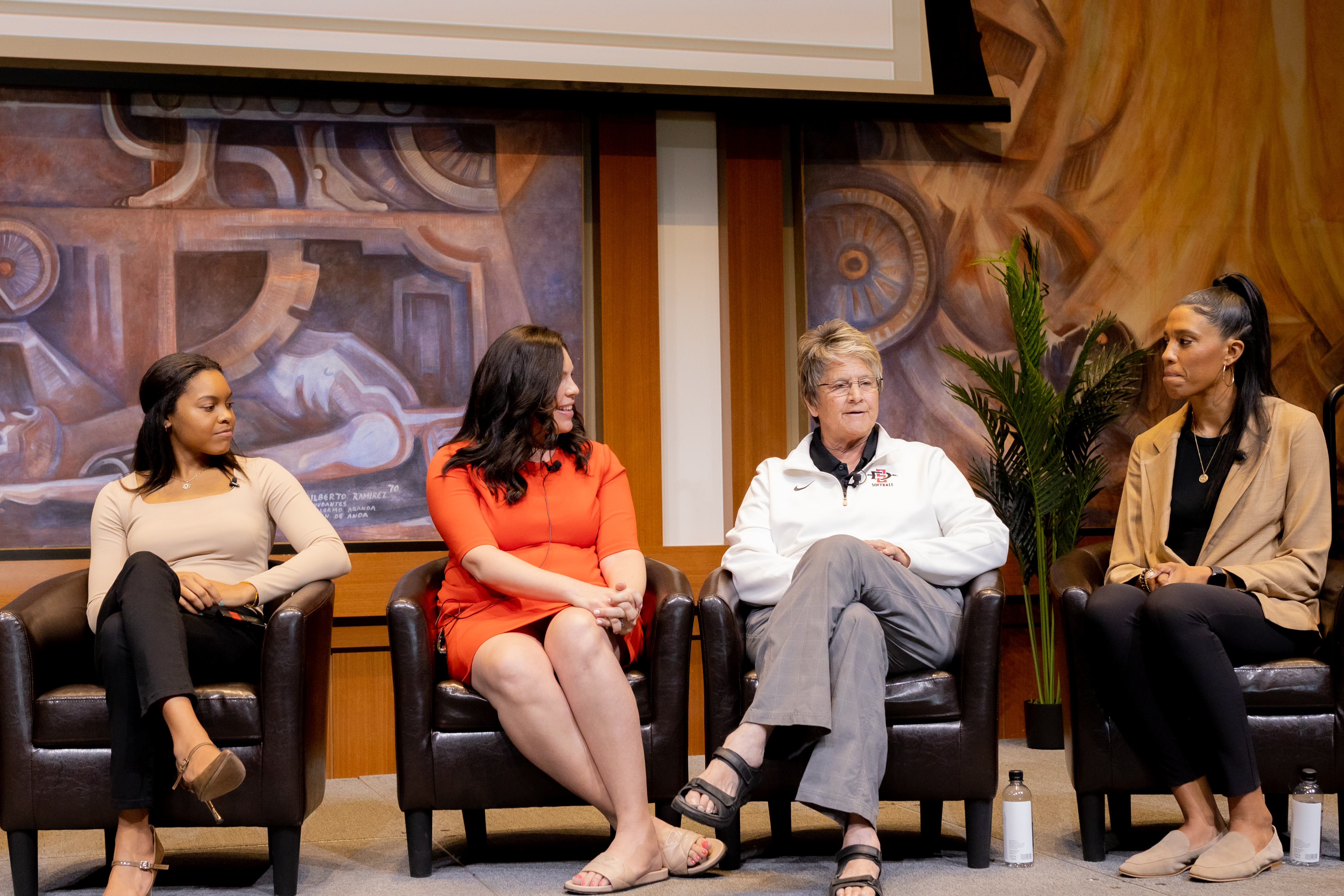
From Left: Cathy Cooper, Angela LaChica, Kathy Van Wyk, Audra Dent.
Following That College Career Path
The panel session kicked off with the question: What was your original career goal/life
goal while you were in college? All four panelists said they were able to follow the
career path they had set into motion during their college years. In addition, each
said they faced adversity from a variety of sources throughout their career paths
and told the audience how they were able to “redirect” their path to reach their goals.
In the case of Dent, her hopes of becoming a professional volleyball player in Europe
were dashed by a shoulder injury, however, it provided her with the incentive to pursue
a successful career in coaching.
Title IX
Three of the panelists have either coached or mentored female athletes and the panel
discussed the impact of Title IX on their lives and careers. “I see Title IX not just as a way to give women equal
opportunity and access to sports, but also as a way to take advantage of the mental
and physical benefits and the lessons learned through sports,” said Cooper, who was
on SDSU’s swimming and dive team as a student. ‘What is really empowering about Title
IX is now we have the opportunity to become leaders in our own lives through sports.”
But Title IX is also “a double-edged sword” said Van Wyk who has been coaching softball for the past 40 years. “I can see that we’re not there yet, but it’s a little more comfortable to fight for it than it used to be,” she said. “One place where we need to keep fighting in athletics is that we see so many men coaching women’s sports and we do not even consider women coaching men’s teams. I think that’s a travesty. And when you see the occasional story of a woman coaching men’s sports on the news, just the fact that you have to put it on the news is a red flag. If you’re a woman considering applying for coaching jobs, throw your name in there because you have nothing to lose.”
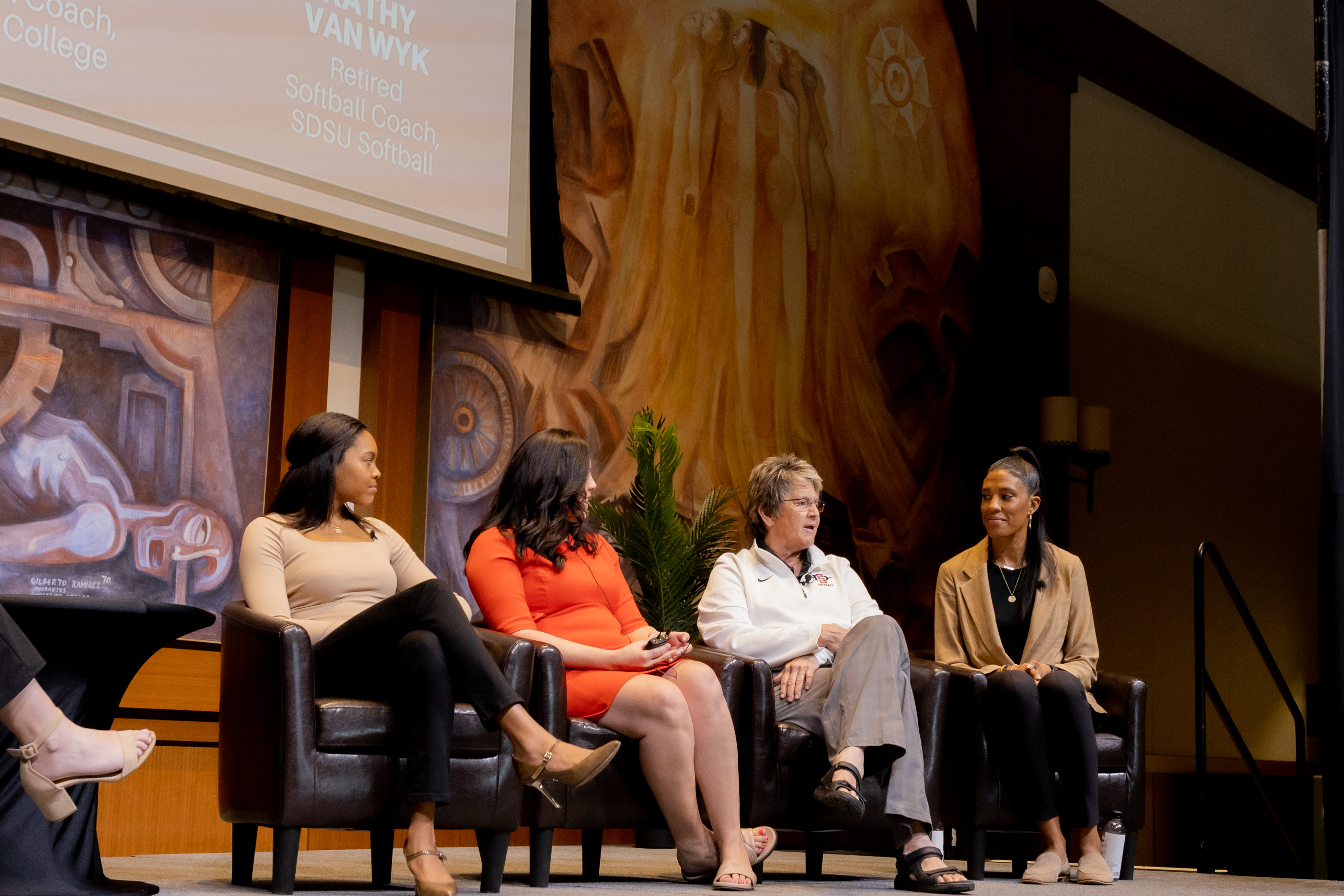
From Left: Cathy Cooper, Angela LaChica, Kathy Van Wyk, Audra Dent.
Going Pro
The next set of questions centered around how SDSU tries to prepare student athletes
for a career after they’ve ended their time as a college athlete. Cooper, who’s written
a soon-to-be published book called “Beyond Her Vision” that focuses on the challenges
faced by young girls in underserved communities, talked about how SDSU helped her
and other student athletes transition into life after graduation with a program called
Aztecs Going Pro. “Most student athletes don’t think a lot about our future since
we’re so focused on just being a student athlete,” she said. “This program helped
me focus on my professional goals in terms of resume building, using LinkedIn and
how we can utilize our strengths as athletes into our careers.”
Thank You, Steve Fisher!
LaChica says she has former Aztecs men’s basketball coach, Steve Fisher, to thank
for her career in sports business. “I was a student manager left over from the last
year’s team when he got here in 1999. He really didn’t want a female around, so he
sat me down and told me that,” she said. “But I asked him to keep me on the team because
I wanted to make

From Left: Jenna Meyer, Cathy Cooper, Angela LaChica, Kathy Van Wyk, Audra Dent.
this my career and Coach Dutcher and some of the other managers went to bat for me. So, he took me on a road trip and after that, things clicked. He gave me that shot and believed in me, so I want to give him credit for my career whenever I can.”
This experience, said LaChica, has made her want to give back to women. She’s hired a “strong team of women” for her business saying “it’s so important to help women in their careers. I am happy to be here, so I want you all to know that you have an advocate in me.”
A Long Way To Go
While the panel agreed that women in sports have come a long way in the past 50 years,
there is still a long way to go. “San Diego State is actually one of the best in the
country for money spent on female student athletes in terms of equipment, support
systems and scholarships, but many, many universities and high schools don’t pay attention
to those things,” said Van Wyk. “They allow booster organizations to spend more money
on the football and men’s basketball team and they don’t add that money into the equation.
There’s not enough people to stand up and say ‘hey, this is wrong!’ and many are afraid
of what will happen to them if they do.”
Dent echoed that sentiment, but she also said that women, especially women of color, have historically limited themselves in terms of coaching careers. “Sometimes, we wonder ‘will they even consider me?’ but the only way they can do this is if you put your name out there and apply for the job,” she said. “I’m a prime example of someone who came from nothing and now I lead junior college athletes. Hopefully, when young women see us, they’ll take a shot at it too since I think it’s the only way we’ll ever achieve true equity.”
Content Creators Panel- “Your Work is Literally Attached to You Everywhere You Go”
The Women in Leadership Content Creators Panel session featured three social media and branding experts, Cynthia Moreno, Mina Park and Megan Reyes, who shared their experiences in the competitive field of content creation and social media. The panelists started the session by offering their background and experience in the field of social media branding, before jumping into their first question about any advice they might have for students or young women who may “get lost in the perceptions or ideas” set forth by social media.
Moreno summed up the question in one word: “Boundaries.”
“When your work is literally attached to you everywhere you go, I’m still learning how to create boundaries, setting my own time, and not letting my work and my life become one,” she said. All three panelists agreed that not taking criticism personally plays an important role as well, and Reyes said that it was also important not to compare your work to others and not worry about your number of followers.
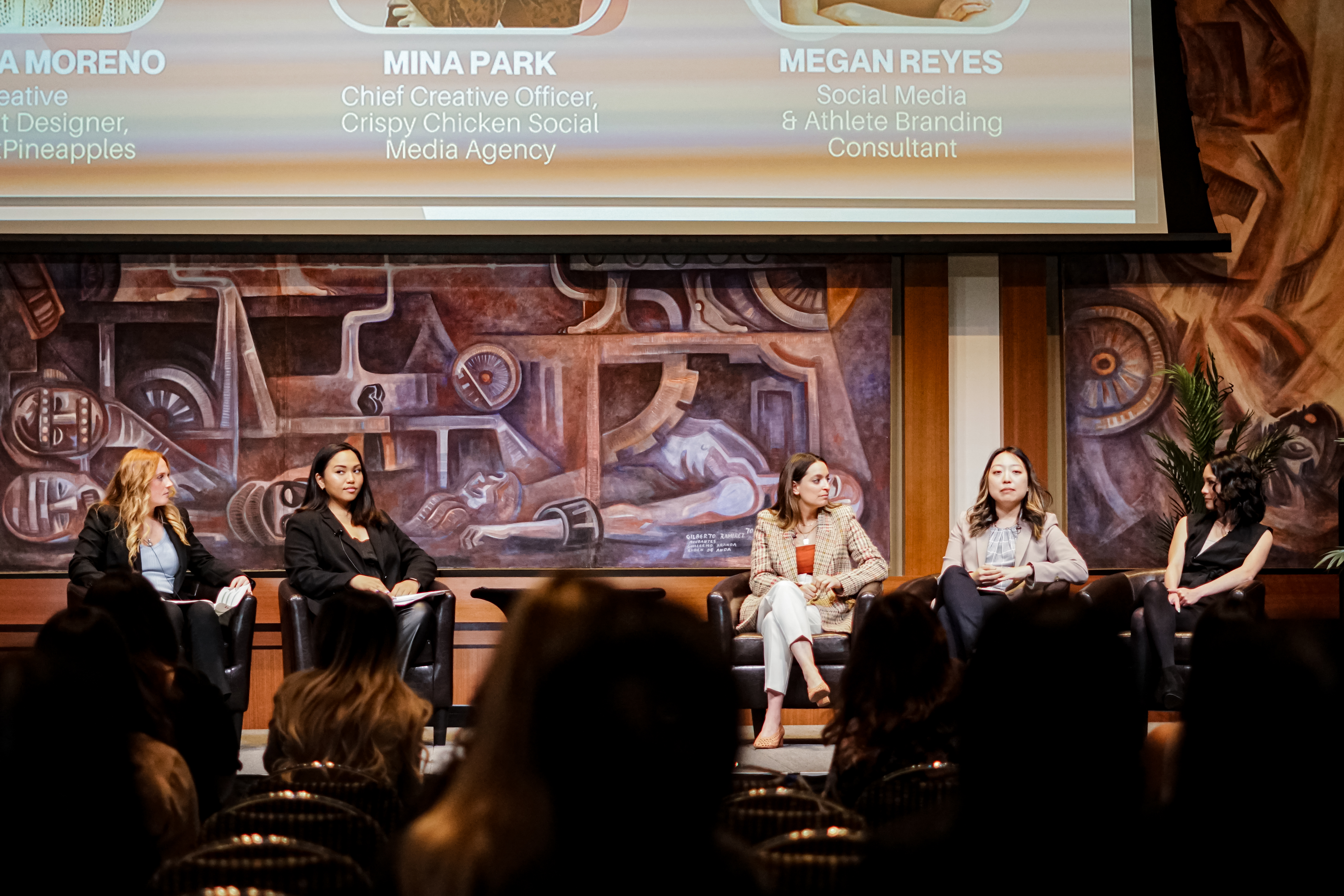
Moderators Meghan Mahoney and Jacq Banal speak with panelists Cynthia Moreno, Mina Park and Megan Reyes.
Not Part of Their Career Plan
All the panelists noted that working in social media wasn’t part of their career plan
during college since that option wasn’t available to them at that time. “I wanted
to have a marketing career in music, but I couldn’t get an internship or any jobs
in the music industry,” said Park. “There were some openings in film and TV, so I
started there, but with the rise of social media, there were more opportunities to
create things on my own and I just went with it.”
Moreno’s route into the world of social media started as something “just for fun” because she said she was “burnt out doing set design and I needed another creative outlet.” When someone approached her and offered to pay her to post an image on her site, she realized that she had a business opportunity, “so it kind of started by accident.”
Getting Started
Reyes’ entry into a career in social media was similar to Moreno’s in that it was
something she said she “kind of fell into,” but that she knew she wanted to work in
the world of professional sports. She caught a break when she was working with the
NBA’s Golden State Warriors when they won three championships in 2015, 2017 and 2018
allowing her to gain followers. “Similar to what Cynthia shared, I realized there
was an opportunity there, but I was still doing social media for fun until I realized
that I was pretty good at it,” she said.
During the discussion, Park advised audience members to ask for help which is something she has struggled with in the past. “There are a lot of times when I think ‘this is my problem or life journey’ and ‘I have to figure it out on my own’,” she said. “But there are so many people willing to help you that put you in positions that will open doors for you. I wished I had been speaking up for myself when I was younger.”

From Left: Panelists Cynthia Moreno, Mina Park and Megan Reyes.
Don’t Panic
The panel all agreed that a person’s major in college was not necessarily the career
path they would pursue. “When you’re 21 and you’re trying to figure out what to do,
you shouldn’t panic,” said Reyes. “You have your whole life ahead of you and everything
will work out.” Reyes also agreed with Moreno’s statement that it is okay to move
in with your parents to save money and help prepare for “the shock of an adult career.”
One topic that was discussed throughout the session was how the panelists got clients and gathered followers. All three agreed that getting work through friends, former and current work associates, as well as using their network and the “ability to believe in yourself” helped them build their businesses.
When asked about what advice they would give to those thinking about starting a business that relies on social media platforms, the panelists advised that a good accountant and a good lawyer, along with a bank account, would be necessities. Park also suggested asking for help and being willing to collaborate with others in your network as well.
As the session wrapped up, the panelists urged budding social media entrepreneurs not to allow the fear of failure to dissuade them from pursuing their passions. “I’m a perfectionist, but I try to remind myself everyday that perfection doesn’t exist,” said Reyes. ‘But even if I make a typo, I have to tell myself to leave it and it will be fine. The world is not going to end.”

